
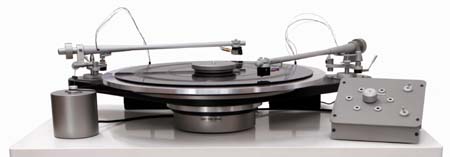
Simon Yorke S10 CAT (Compact Archival Turntable)
The Audio Archive worked closely with Simon Yorke Designs by providing design feedback during the development phase of the Simon Yorke Designs S10 CAT (Compact Archival Turntable).
We have been using the Simon Yorke S7 at The Audio Archive since 2004 for professional archival and re-mastering work. In addition to using the S7 in our facility, we have built integrated disc transfer systems for clients which incorporate the S10 CAT.
We selected the Simon Yorke Designs turntable for our facility because:
- Audiophile quality sound over a wide range of obsolete disc media is a top priority
- Modular design allows us to engineer our own custom adaptations for obsolete media. It is a versatile archival "platform".
- Modular design protects our investment by providing compatibility with new features and performance enhancements from Simon Yorke Designs
- Unsuspended design allows us to choose the best vibration isolation solution for our environment
- Critical bearings are quiet and oversized, providing long life in a production setting
- Easy to service design keeps our operations up and running at all times
- Simon Yorke Designs provides extremely responsive customer service
The S7 turntable, while not inexpensive, was one of the best investments we made in terms of capability, upgrades and reliability. However the S7, as an audiophile and pro-sumer product, was missing many of the advanced archiving features that are found on its much more expensive big brother, the S7 Professional Archival Turntable (PAT) that is used at the United States Library of Congress.
Although The Audio Archive has modified its S7 turntable system to meet our needs, Simon Yorke Designs does NOT condone or support user modifications of their products. As the adage goes, "you're on your own" if you make any changes to the Simon Yorke Designs record player. However, more importantly, many of the modifications that we made to our S7 have been addressed by the new S10 CAT.
The new S10 CAT really does close the gap between the S7 and the S7 PAT by adding some of the same capabilities found in the S7 PAT. The S10 CAT is simpler and more "manual" in nature when compared to the S7 PAT, as it lacks digital speed control and the computer interface needed for automation. And the S7 PAT also can perform other "tricks" that the S10 CAT cannot, like native playback of Constant Linear Velocity (CLV) discs.
Nonetheless, the S10 CAT adds a number of critical features for archival and re-mastering work, including:
- Six user-defined preset speeds ranging from 14 RPM to nearly 120 RPM
- Reduced diameter spindle with removable collar for eccentric discs
- Change disc platter size without changing VTA
- Reversable play for metal parts
The S10 CAT still retains many of the features of the S7, including
- Modular design
- 7.1 univpivot tonearm, which has an ingenious cartridge mounting design that can be reversed to obtain the correct Horizontal Tracking Angle (HTA) for reverse play of metal parts.
- Graphite platter mat
CAT Motor Controller
The S10 CAT introduces a new motor controller that increases the range of turntable speeds:
- S7 = 33 RPM to 78 RPM (factory design)
- S7 = 24 RPM to 90 RPM (as modified by The Audio Archive)
- S10 CAT = 14 RPM to 120 RPM
The wider range of speeds and settings has clear benefits
- Support for a wider range of media
- Slower speeds for working with damaged media
- Slower speeds for working with obsolete dictation disc formats
- Faster changeover between non-standard speeds
- Finer speed control for the most commonly used speeds
Below is a map of turntable speed versus CAT control position and motor pulley size. We were a bit skeptical about the efficiency of changing pulleys, but Simon Yorke proved us wrong and the pulleys are indeed quick and easy to swap.
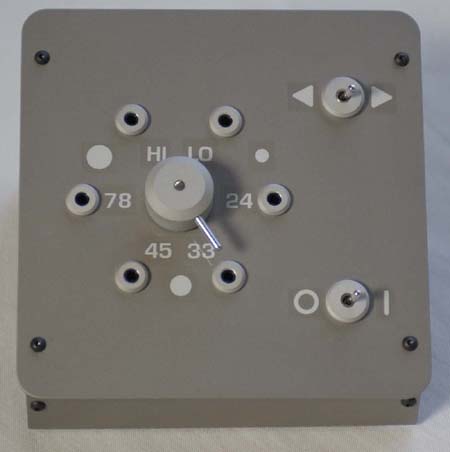
The CAT Motor Controller with its six pre-set speeds. The faceplate comes unlabeled so that the user can choose how to configure each pre-set. Different pre-sets combined with different pulleys will provide different speed ranges. We created our labels using a Brother P-Touch labeler.
Large Platter for Full Disc Support
At the time of this writing, Simon Yorke Designs is the only producer of turntables with a full 16-inch platter to completely support large transcription discs from edge to edge. Full support of large discs is especially important for sound quality as an unsupported disc will act as a kind of "sound board" and will resonate during playback as the disc gets excited by tvibrations induced by the cartridge. An optional 20-inch platter is also available.
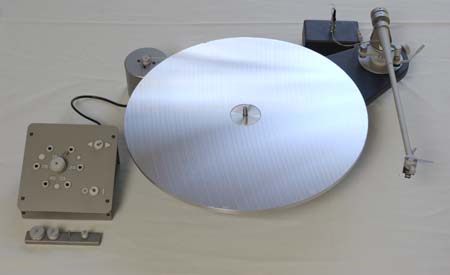
S10 CAT with 16-inch platter. Shown with platter mat removed. Note the pulley rack in front of the CAT motor controller.
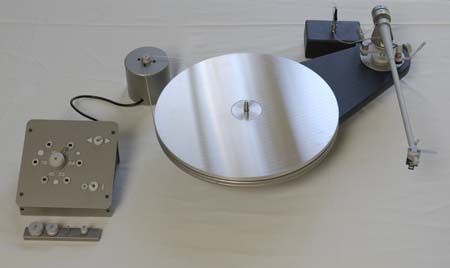
S10 CAT with 12-inch platter. Shown with platter mat removed. Note that there is no change in the height of the platter surface when changing platters, so there is no need to change VTA.
Spindle with Removable Collar
Simon Yorke Designs provides a clever and effective solution to the problem of playing commercial discs with spindle holes that are not punched exactly in the center of the disc.
Simply remove the collar from the spindle, and you are left with a smaller diameter spindle. Now you can offset the disc as needed to get the grooves centered on the platter. This works well for most discs with spindle holes which are slightly off-center. For discs with grossly off-center spindle holes, the entire spindle can be removed.
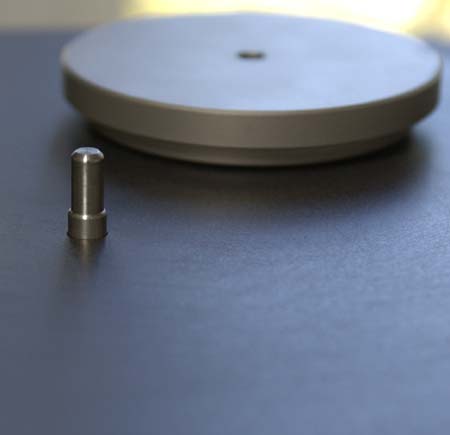
Spindle with collar in place for discs with well-centered spindle holes. Record weight is shown in the background. Turntable mat is graphite.
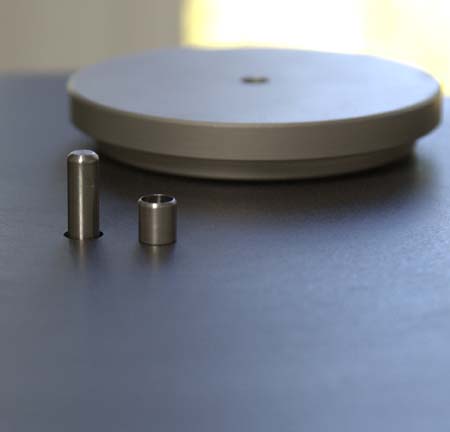
Spindle with collar removed for discs with off-center spindle holes that result in eccentric disc playback. By removing the collar, it is possible to center discs with small eccentricities on the platter. Once the disc is centered, the record weight (in the background) can be placeed on the disc to keep it in place.
For more product information, please write:
or call us at:
+1 (408) 221-2128